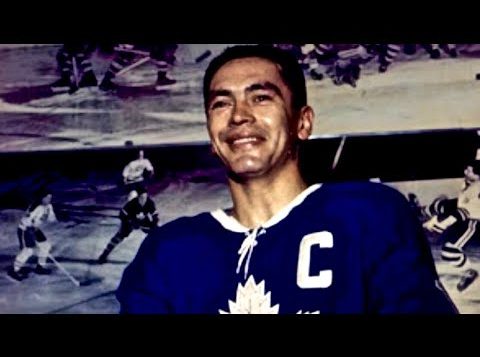This Day in Hockey History – July 6, 1930 – Chief of the Leafs
George Armstrong’s summer birthday on July 6, 1930 gave little indication that he would become a professional ice hockey player. However, his birthplace 25 kilometers northeast of Sudbury in Northern Ontario certainly did. He would not leave the province as he grew up to become the longest-serving captain of the Toronto Maple Leafs.
Armstrong was born and raised in Ontario. His birthplace, Skead, is on the south shore of Lake Wanapitei. He then grew up in Falconbridge, less than 15 kilometers south. His father, of Scottish (or Irish) background, mined for nickel. Armstrong’s mother had Ojibwe (or Algonquin) heritage. When he played with the senior Marlboros for the Allan Cup in 1949, the Stoney Indian band (in Alberta) named him “Big Chief Shoot-the-Puck” in honor of her heritage. The Marlboros were affiliated with the Maple Leafs, who had signed Armstrong when he was 16.
After a couple of NHL games in December that year, Toronto brought Armstrong up from their AHL affiliate during the 1951-52 season (having just won the Stanley Cup). On February 9, he became the first player of First Nation descent to score in the NHL when he potted the game-winner. Toronto’s assistant manager, King Clancy, claimed, “This kid’s got everything. He has size, speed, and he can shoot ’em into the net better that any hockey player I’ve known in a long time. I’ll be surprised if he doesn’t become a superstar.”
Owner and manager Conn Smythe noticed Armstrong’s leadership qualities and made him the team captain in 1957. The Leafs switched his sweater to No. 10. Smythe had often been quoted as referring to Armstrong as “the best captain, as a captain, the Leafs ever had.” He ended up being the last Leafs captain to play his entire career with the team.
During Armstrong’s 21-season career with the Maple Leafs, they made the playoffs 15 times and the Stanley Cup Final during six of those. Under Armstrong’s captainship, the Leafs won four Stanley Cup championships, three consecutive times from 1962 through 1964 and again in 1967. They first defeated the defending-champion Chicago Blackhawks then the Detroit Red Wings twice. For the last hurrah, Armstrong scored an empty-netter as the ultimate goal of the 1967 Final (against the Montreal Canadiens) and consequently of the entire Original-Six era. The Maple Leafs have not won the Cup again since.
Armstrong tried to retire in 1970 but agreed to play one last season. He retired in 1971 at the age of 40. He had played the most seasons (21), regular-season games (1188), and playoff games (110) in Toronto’s history. At the time, he had the second-most regular-season points (713) and the most playoff points (60).
Once his playing days ended, Armstrong returned to the Toronto Marlboros as coach, and they won the Memorial Cup twice. Following a stint as scout for the Quebec Nordiques, he returned (in 1988) to the Maple Leafs as an assistant general manager and scout. Armstrong was inducted into the Hockey Hall of Fame in 1975 and had his No. 10 retired by the Maple Leafs in 1998.
Additional Sources:
- https://www.hockey-reference.com/players/a/armstge01.html
- https://www.hhof.com/LegendsOfHockey/jsp/LegendsMember.jsp?mem=p197501&type=Player&page=bio&list=ByName
- https://www.hhof.com/htmlSpotlight/spot_oneononep197501.shtml
- https://www.nhl.com/mapleleafs/news/george-armstrong-the-chief/c-753980
- https://books.google.com/books?id=5bako-2zzKQC&pg=PA19&dq=george+armstrong+copper+cliff&hl=en#v=onepage&q=george%20armstrong&f=false
- https://hockeythenandnow.blogspot.com/2011/03/
- https://www.newspapers.com/image/500846383/?terms=%22George%2BArmstrong%22%2Bleafs%2B%22first%2Bgoal%22
- http://anishinabeknews.ca/2017/12/22/maybe-leafs-need-another-chief/














